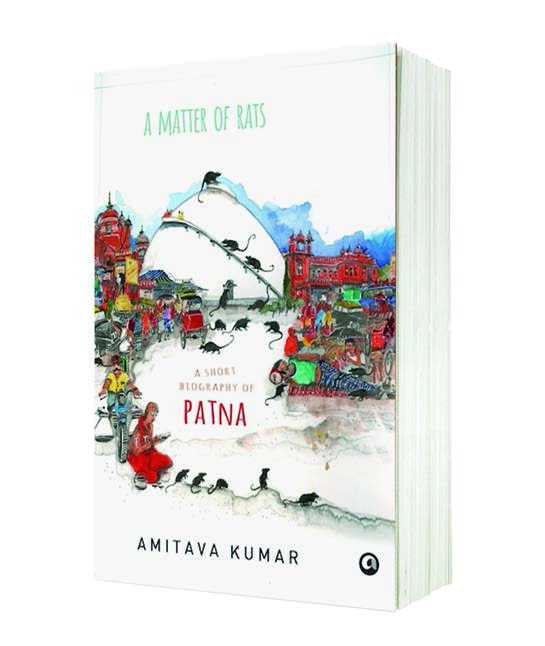By Amitava Kumar
Aleph Book Company
Rs. 295
Cities are thinking, living beings. They never remain constant, especially the more excited ones– the metropolises. People can give you a phrase or a word, “electric” or “edgy” and you can spend all your evenings and days in company of that city not knowing why was that the right word used to describe the space.
But what do you do with cities that have fallen– not ‘fallen’ in the sense defeated but declined, with time? Cities that once were the darlings of the rich, famous and the shining, the courtesans that once captured the heart of many a traveller but are no longer quite their former selves. The tides of time have swept them out of the circles of power and wealth. They lie on the periphery. What do you do with them? You write their biographies: short, pithy ones titled A Matter of Rats.
Of course, the title suggests many other realities as well. The enterprising, infesting ways of rats, the habits of hidden plundering, and above all, always surviving.
It is a biography of Patna.
The book is a memory exercise. Memory that interacts with the present, memory that interacts with other memories; an emigrant’s interaction with the ‘left-over Patna’. The author, Amitava Kumar, had left the city decades ago and, as he acknowledges, he now only visits the city to meet his parents. But while he was elsewhere, he was always looking for the city that was once his own. He looked for it in articles in ‘Granta’, in the acerbic writings of Shiva Naipaul (the lesser-known brother of V.S. Naipaul), in the brief mention of the city made somewhere by William Dalrymple, and in the fresh blood that a new author has drawn on to write his debut novel. All these glimpses of his city, as seen by others, are included in the book. It’s as if the author is trying these many lenses, not sure whether he should just follow his own. Is this merely the academic’s search for the views from inside and out, or is he looking for validation in other voices that his city is somehow still relevant?
Amitava Kumar is an academic and a journalist. He wants to be objective. He narrates incidents off the highway of the new Bihar, the hunting of rats by Musahars, a bureaucrat’s most imaginative device to socially engineer the Musahars’ integration into Bihar’s horribly casteist society. He even tries to keep an even keel while observing a love story that has gone sour, as intellectual life is draining out of the city and a new consumerism is coming in.
In that sense, the book is a reflection on many other north Indian cities, like Lucknow and Allahabad, that were once centres of urban relevance, havens for artists, artistes and literary figures. What Kumar observes of Patna’s failings is sadly also true of these other cities. Their present day realities look like messier and uglier copies of a Delhi or Mumbai. Delhi’s malls are nothing to take pride in, but at least they seem to honestly belong there. The middle class and its aspirations across India makes the presence of a ‘P&M’ Mall in Patna something of a baroque display. “Me too.”
Nowhere in Patna can one see any awe-inspiring relic from its 2000 years of continuous history. And centred in this loss, is the author’s struggle to not reject his own identity, “I told stories about Patna because they were a part of my shame at having come from nowhere… It took me time to learn that what I thought as honesty, the honesty required of a writer, was also a rejection of who I was.” It is a rejection, which is very familiar to many Biharis.
This biography is not objective. It matters that the person writing it is a Bihari in exile, someone who lives in New York – that centre of modern urban celebration and decadence, a city which every city in the global south mulls over, aspiring to be yet unable to leave behind a history gone irrelevant in a globalized world.
Bihar is feudal, abjectly casteist. It lives in that history even today. For many communities, if they are to evoke pride in a collective identity, it is in their own communities; the Yadavs for the Yadavs and the Rajputs for the Rajputs. There is no overarching icon that transcends these barriers and no one single Bihari whom all classes and castes love. Cities usually become melting pots –spaces where one can give up these different identities and take up something new. But that is not the story of Patna and that is not the story that could be told.
In that sense, it is a biography of that which is relevant for much of the educated elite that has left Patna, that which many of them perhaps feel on reflection, once they have left the city. But the book does try and engage with other Patnas as well. It addresses the Patna of those who have stayed back and are trying to put together a new Patna and the Patna of those who can’t run away to Delhi or Mumbai and must fall back on this lesser city to help them survive.
The book is not about Patna’s 2000 years of history; it hardly could be in 150 pages. It is about memories, and the scanty history – culled from the last 100-150 years of the city’s past – that the author pulled in to give relevance to the memories he relates. Nonetheless, it is relevant. It made me happy, nostalgic, reflective and sad.
It also presented me with many what ifs. What if the author was not an exile but someone living in Patna, someone who had the objectivity to look at the nooks and crannies of the city and its feudal past and present without losing sight of its relevance in current times? What if the memories recounted in the book was of the author and his city having lived their biographies together? Would that biography have been different? Would it have been more broadly relevant?














